Key Takeaways
- Metallic accents bring sparkle and depth to any room.
- Blending metals with everyday colors can shift your home’s look from plain to polished.
- Balance is key: too many metallic items might feel overwhelming, while a few well-placed pieces can tie the entire space together.
- Match metal finishes to your existing decor style for a seamless effect, or mix metals thoughtfully for artistic flair.
- Metals reflect light, which can help brighten darker spaces or give a cozy glow to dim corners.
- Strategic use of metallic elements can make your home design feel unified and dynamic.
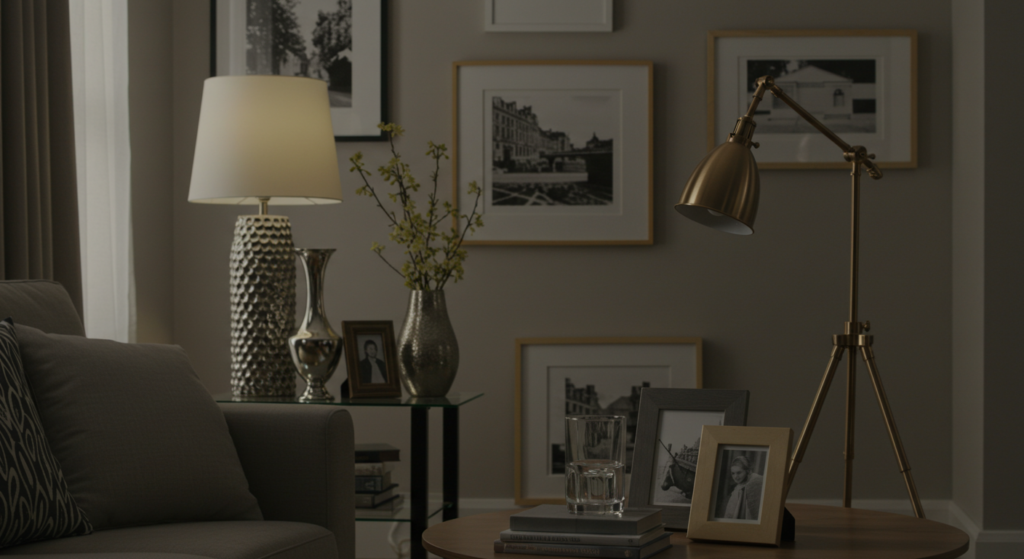
Ever dream of adding a special shine to your living space without going too far? Metallic accents might be the answer. They add subtle brightness, create visual interest, and highlight the colors already present in a room.
But how do you pick the right metals, and where do you place them? Some folks worry that metallics might clash with their favorite shades, or that they’ll end up overdoing it. Yet when approached with care, these accents can elevate even the simplest setting.
Are you curious about brushed brass cabinet handles or a few copper table lamps that make your sofa pop? In this guide, we’ll explore a wide range of techniques.
We’ll see how different metals play with diverse palettes, how to maintain that polished gleam, and how to blend metals in ways that look creative but don’t feel random.
We’ll also tackle practical questions like how to arrange these pieces without overshadowing the rest of your decor. Ready to shine?
The Basics of Metallic Accents

Exploring the Appeal
Metallic accents, such as gold, silver, and brass, give an undeniable lift to almost any color scheme. Their reflective surfaces can create points of brightness in rooms that need a little extra glow. They can also bring out subtle hints in your favorite paint colors or fabrics. Wonder if that plain white wall can feel more vibrant? A few shiny objects might do the trick.
Why They Blend So Well
Metals work with both bold and soft hues. Bronze can add warmth to navy or forest green, while polished chrome can unify a cool, modern palette built around crisp whites or grays. Their gleam tends to highlight textures in furniture or accents you already have. For example, a brushed copper pendant light can highlight the grain of a wooden table nearby, making the entire spot feel special.
Common Concerns
Worried about going overboard with shimmer? Placing too many metallic items in a single room can create a confusing clash. Instead, sprinkle them strategically. Use a large mirror in a shiny metal frame, or a single coffee table with metallic legs, and let these pieces shine alone. When in doubt, start small and see how your space reacts.
Popular Metals and Their Unique Touch

Gold: Traditional Yet Timeless
Gold has a classic appeal. It pairs well with warm neutrals like beige or cream, adding a sense of richness without appearing dated. A gold-framed mirror against a taupe wall often feels stately. Gold picture frames can also bring an almost regal note to living rooms or entryways. If you worry about gold looking too formal, offset it with natural textures like rattan baskets or soft linen drapes.
Silver: Sleek and Contemporary
Silver has a cooler tone and a sleek, polished appearance. It frequently appears in modern spaces that favor minimal lines and neutral color palettes. Ever notice how silver lamps pair elegantly with gray couches or off-white walls? When used with bolder shades, silver tends to accent them rather than compete. For instance, in a room that features bright teal pillows, silver curtain rods can tie things together.
Copper and Bronze: Earthy and Inviting
Copper leans toward pinkish or orange notes, while bronze leans toward deeper browns. Both can warm up a space. Copper can stand out against navy or slate, creating a cozy nook. Bronze, on the other hand, can mingle nicely with rustic settings, especially those featuring exposed brick or dark wood. These metals can add comfort, especially in rooms where you want a more laid-back vibe.
Pairing Metals with Interior Design Styles

Modern Minimalism
Modern designs often revolve around monochromatic backgrounds, clean lines, and open spaces. Polished chrome or brushed nickel often fit well here, thanks to their sleekness. Want a subtle pop? One large piece, like a stainless steel coffee table, can serve as a focal point. Keep the rest of the room clutter-free to let that standout piece shine.
Vintage Glam
Classic chandeliers, tufted chairs, and mirrored surfaces define this style. Gold or brass finishes typically reinforce a vintage look. Think of a grand living room with plush velvet sofas and a glimmering gold bar cart on the side. For an extra flourish, choose ornate frames for art pieces, blending them with subtle pastel walls.
Rustic Farmhouse
Warm wood textures, cotton fabrics, and distressed finishes often appear in farmhouse designs. Copper and bronze fit this style, adding a comforting glow against white shiplap or warm oak floors. A set of copper cookware can look charming in a farmhouse kitchen. For living areas, bronze lantern-style lighting can enhance that cozy country vibe without stealing the spotlight.
Creating Balance Between Colors and Metals

Assessing Your Existing Palette
Before adding metals, examine your current color choices. Are you using mostly pastels, neutrals, or jewel tones? A balanced approach involves choosing one or two metal finishes that will blend smoothly with these existing shades. If your walls are earth-toned, consider warm metals. For more neutral or cool shades, look at silver or pewter.
Mixing Metals Carefully
Do you love rose gold but also enjoy brushed nickel? Mixing metals can work if you organize them. Keep one metal as the star and let the other serve as an accent. If you have a rose gold mirror, maybe use brushed nickel knobs on nearby cabinets. This way, the eye moves across the room without fixating on a single overly reflective cluster.
Managing Saturation
Metallic finishes can easily stand out, so keep them in proportion. A few scatter cushions with metallic thread can complement a brass table lamp, but you probably don’t want every lampshade, vase, and photo frame to be shiny. Plan your metal pieces as though you’re adding seasoning to a dish—enough to bring out flavors, but not so much that it drowns them.
Rooms That Benefit Most from Metallic Accents

Living Room
Seating areas sometimes need a focal point. A metal-framed coffee table, or even a bold silver sculpture, can anchor the room. If you have an accent wall in a darker shade, place a few metallic photo frames there to catch the light. This strategy can keep the space looking cohesive, while still offering a nice contrast.
Kitchen
Stainless steel appliances are common, but that doesn’t mean you can’t introduce other metals. A copper backsplash behind a stove can set the kitchen apart. Mixed-metal hardware, like brass cabinet pulls next to a chrome faucet, can add a bit of edge. Try to keep your metals consistent or complementary, so the room doesn’t feel jumbled.
Bathroom
Bathrooms often feature smaller surfaces, which means you can be more daring. A brushed brass faucet can add an upscale vibe next to a white porcelain sink. If your bathroom already has chrome elements (like shower fixtures or towel racks), consider matching your vanity lights to keep it uniform. A single contrasting metal piece, such as a decorative bronze shelf, can stand out in an interesting way.
When and How to Go Bold
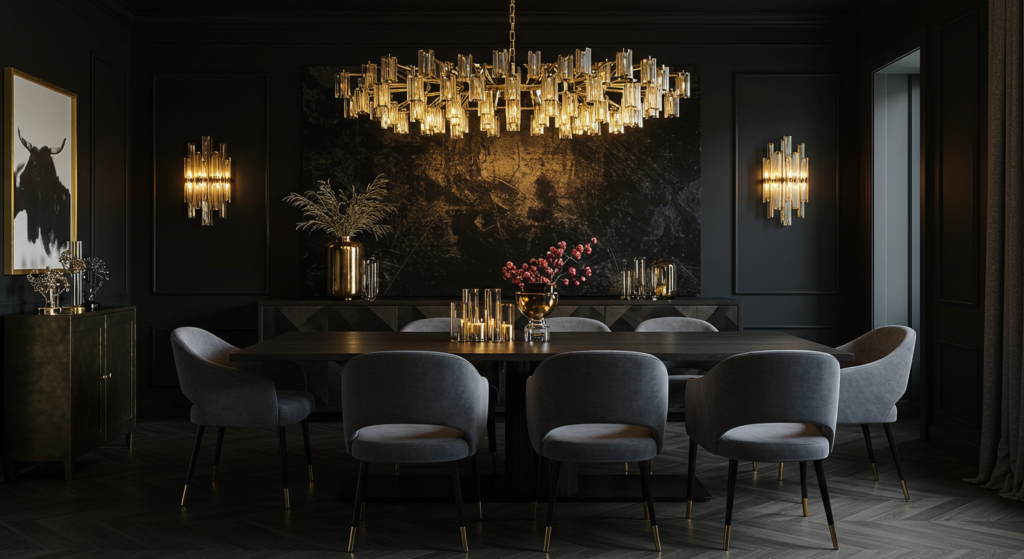
Statement Pieces
Sometimes, a single bold metallic piece can redefine a room. A grand gold chandelier over a dining table can spark conversations the moment guests walk in. A tall, sculptural floor lamp in polished silver can also bring drama. In such cases, keep other metals in the background or skip them altogether to avoid clashing.
High-Contrast Color Pairings
Pairing metals with darker walls can create striking results. Picture a matte black accent wall hosting a series of gleaming brass candleholders. Or consider midnight blue cabinets fitted with copper handles. These vibrant contrasts can feel edgy, yet inviting. If you lean toward lighter shades, you can still go bold by choosing metallics that have a strong shine or an unexpected shape.
Using Patterns and Metallic Surfaces
Don’t want plain white curtains? Some designs include metallic threads that form geometric shapes. These add dimension without being too overwhelming. Similarly, wallcoverings can feature hints of metallic ink. A wallpaper with a subtle gold swirl can elevate a hallway or powder room. Just make sure you sample a small area first to see if you enjoy the effect.
Common Mistakes to Avoid
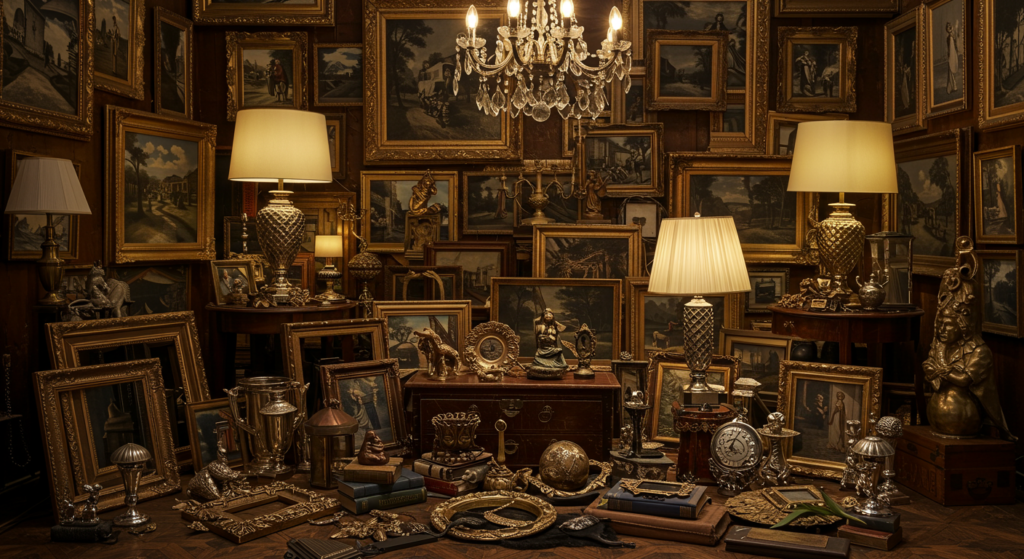
Overcrowding with Shine
Adding too many metal surfaces in one spot can distract from your overall design. For example, a living room with gold-framed art, brass side tables, copper planters, and silver photo frames might feel chaotic. Try layering, and let each piece breathe.
Ignoring the Room’s Function
Think about how you use the space. A glitzy chandelier in a functional kitchen might gather grease or get in your way. Meanwhile, delicate metals in a high-traffic mudroom might scuff too easily. Always align your choices with how the area is used.
Forgetting Maintenance
Many metals need care to keep shining. Brass items might tarnish over time, and copper often develops a patina. If you’re not ready for upkeep, go for options that are sealed or coated to reduce daily polishing. Likewise, be realistic about water exposure. Metal fixtures in a bathroom need a finish that won’t corrode under constant moisture.
Making Small Spaces Feel Larger

Reflective Tricks
Mirrors in metallic frames reflect light and add the illusion of more space. A narrow hallway can seem bigger if you place a tall mirror on one side, bouncing sunlight from a nearby window. Even small metallic decorations, such as chrome hooks, can catch overhead lighting in cozy rooms, adding brightness.
Strategic Placement of Metallic Furniture
In a cramped living room, a side table with a metal base often looks more open than one made from heavy wood. This is because metal legs, especially if slender, don’t block the view of the floor. This visual continuity helps a small room feel less packed. Also, lighter metals like nickel or chrome can make a tight area look more airy.
Coordinating Colors to Maximize Light
If you want to enhance brightness, consider using pastel walls or lighter neutrals. Then, add a few metallic objects at key points where light naturally falls. This setup helps bounce that light around, making the space look more open. Keep fabrics or rugs in soft shades so they don’t absorb the glow that metals reflect.
Mixing Old and New Elements

Blending Vintage Metals with Modern Decor
Antique brass knobs on a contemporary white dresser can add charm. A vintage copper pendant lamp can hang over a glossy dining table, combining rustic notes with a fresh design. The trick is to keep your color scheme coherent. If your walls are warm, vintage metals often blend smoothly.
Updating Outdated Fixtures
Have old doorknobs or dull cabinet pulls in an otherwise updated home? Replacing them with sleek metallic accents can tie your renovation together. If you’re drawn to older metals, you can keep the original charm by cleaning and sealing them. This refresh can update your space without losing its authentic character.
Reimagining Family Heirlooms
Got a metal-trimmed mirror passed down through generations? Place it in a room with a modern accent wall so it feels intentional, not out of place. When merging older items, aim to anchor them with at least one more piece that carries a hint of the same metal. This helps each item appear related, rather than random.
Outdoor Spaces and Metallic Details

Patio Furniture and Accessories
Outdoor areas often include metal furniture due to durability. Aluminum chairs are lightweight, while wrought iron tables bring classic charm. Don’t forget smaller accents like planters or lanterns in a matching finish. If you have a vibrant outdoor rug, you can pick a metal tone that complements its primary color.
Choosing Weather-Resistant Metals
Galvanized steel or powder-coated aluminum can stand up to the elements. Copper roofing accents might develop a patina, which can be a pleasant effect for some. Keep your local climate in mind. Harsh winters might require sturdier finishes, while rainy environments call for rust-resistant metals.
Coordinating with Exterior Paint
Your home’s siding color can guide your choice of outdoor metal features. If the exterior is warm-toned brick, consider bronze or copper lighting fixtures near your front door. If you have a cool gray stone facade, brushed silver or stainless steel might blend best. These subtle choices keep your home looking well-composed even from the curb.
Texture, Finish, and Surface Appeal
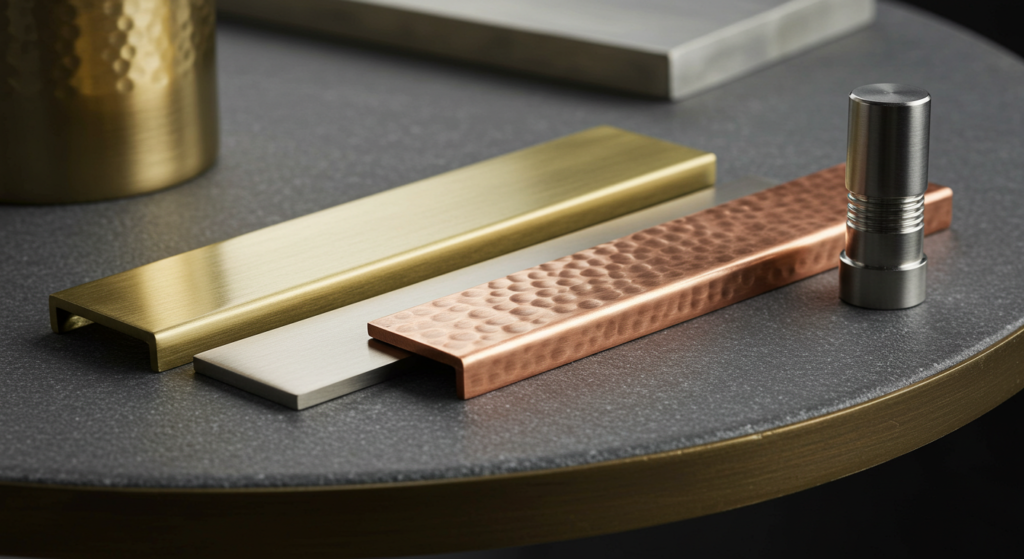
Brushed vs. Polished
Brushed finishes have an understated feel, dispersing light without a harsh reflection. They can suit modern or industrial-inspired spaces. Polished finishes, on the other hand, deliver a mirror-like sheen that can feel bold or even glamorous. If you want your space to appear softer, pick brushed. If you aim for drama, go polished.
Hammered Metals
Hammered metals add depth to your decor. Items like hammered copper trays or hammered stainless bowls can become quick conversation starters. They reflect light in uneven ways, which can create interesting highlights in a room. These pieces also tend to hide smudges and minor scratches better than smooth surfaces.
Matte Metallic Options
Matte metallic finishes have gained popularity for their subdued look. They hold the color of the metal without an intense shine, suiting spaces where you want a calm glow. Matte black hardware, for instance, can blend into a minimalist bedroom, while still standing out enough to draw attention if paired with a lighter wall color.
Practical Tips for Cleaning and Maintenance

Protecting Against Moisture
Bathrooms and kitchens expose metals to steam and water. To keep them shiny, wipe them down often with a soft cloth. If you notice water spots, address them quickly so they don’t become permanent. You might choose sealed metals for these areas to reduce the maintenance load.
Gentle Products for Polishing
A mild soap solution can remove most dirt. For stubborn tarnish on metals like brass or copper, gentle polishes exist. Always test a small area first to avoid damaging the finish. Abrasive pads can scratch surfaces, so opt for microfiber cloths. Regular dusting prevents buildup that can dull the gleam.
Handling Heirlooms or Special Pieces
If you have older metal items with sentimental value, consult a professional restorer for any major repairs. When cleaning them, go slow and avoid harsh chemicals that might erode delicate layers. A little care can keep these pieces looking fresh for years, preserving both their shine and their heritage.
Budget-Friendly Ways to Add Metallic Touches
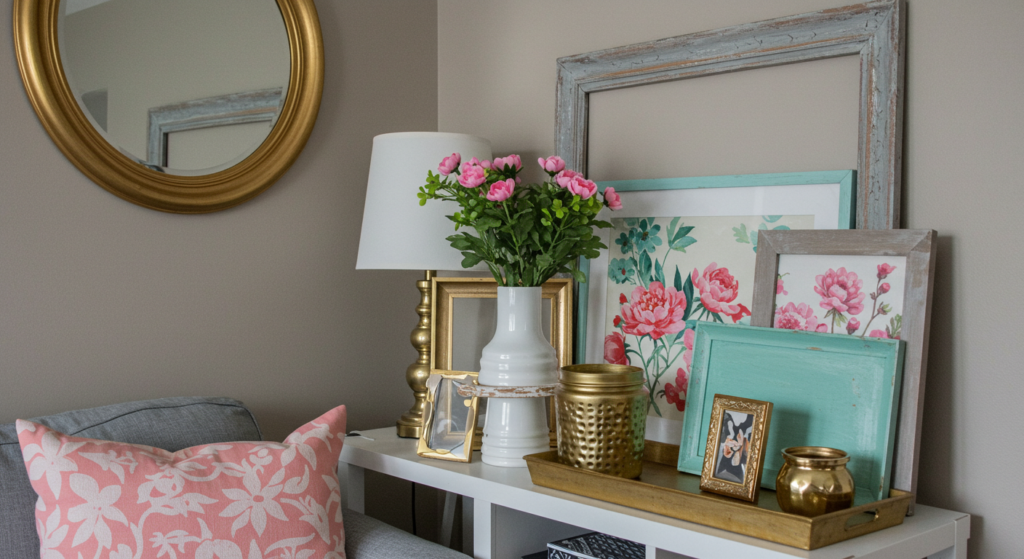
Small Accents and DIY Projects
Don’t want to break the bank? Start small. Metallic vases, candleholders, or picture frames can be swapped in easily. If you enjoy crafting, metallic paint or foil can transform an old item. Try painting the edges of a wooden tray with gold leaf for a custom look. With some creativity, you can revitalize everyday decor.
Thrift Store Finds
Flea markets or thrift shops often hold hidden metallic treasures at affordable prices. You might find a vintage brass lamp missing a shade or a stainless steel serving platter that just needs a little polishing. Repurposing such items brings uniqueness to your home and can be kinder on your wallet than brand-new designer pieces.
Mixing High and Low
Sometimes it helps to splurge on one high-end piece and mix it with budget-friendly accents. For instance, invest in a set of quality copper cookware you’ll use daily. Then, top off the kitchen with more affordable metallic items like simple rose gold utensil holders. The mix of fancy and thrifty pieces can look well-rounded when tied together by a shared metal tone.
Coordinating Different Rooms with Metallic Accents
Keeping a Thread of Consistency
Homes with many rooms can still maintain a unifying theme. One way to achieve this is by repeating the same metallic finish across different areas. If your living room has matte black hardware, consider using matte black cabinet pulls in the kitchen. This subtle repetition helps your home feel joined instead of disconnected.
Allowing Each Room Its Own Twist
That said, each room can have a different dominant color. Perhaps your living room is based around pale grays with silver accents, while your bedroom leans into creams with gold details. The goal is to avoid abrupt transitions. You could integrate small silver pieces in the bedroom, or use a few gold-trimmed pillows in the living room so the change doesn’t feel jarring when you move from space to space.
Flow from Public to Private Spaces
Rooms that guests frequent, like living rooms or dining rooms, might have bolder metallic choices. Bedrooms or home offices, being more private, can incorporate softer or more subtle finishes. This natural shift in intensity gives visitors a sense of progression as they move through your home, guiding them visually from one area to another.
Combining Fabric and Metallic Accents
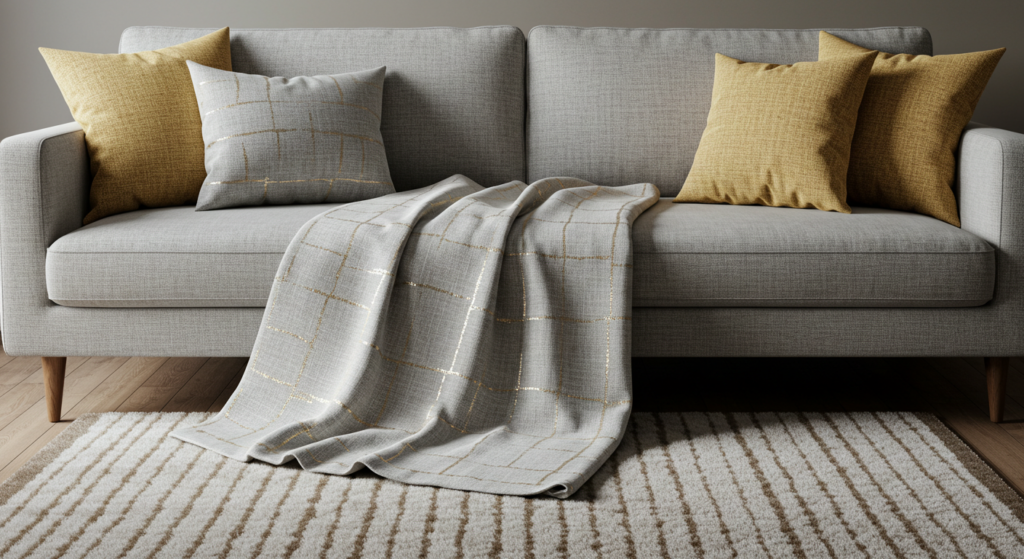
Throw Pillows and Blankets
Soft textures paired with shimmery threads can create a nice contrast. Metallic thread woven into pillows adds a hint of shine without a big commitment. If you want to highlight your sofa’s hue, a pillow cover with subtle gold or silver details can do the job. Consider patterns that echo shapes in your furniture or artwork so it all feels cohesive.
Curtains and Drapes
Metallic accents in window treatments can reflect daylight in a gentle way, adding glow to the room. Some drapes have small metallic stripes or embroidered edges that catch the morning light. If your walls are neutral, these shiny hints can prevent the space from feeling too plain, while still letting your main color choice stand out.
Rugs with Metallic Highlights
Rugs that include metallic accents can make a bold statement. Look for designs that feature metallic threads woven into geometric or abstract patterns. These are especially eye-catching in rooms where the floor acts as a major focal point, such as a wide-open living area. Be sure to test how it feels underfoot and if it fits the room’s overall look before you commit.
Conclusion

Metallic accents offer a dazzling way to balance or amplify your home’s color scheme. Whether you choose gold, silver, copper, or more unconventional finishes, metals can enhance your walls, furniture, and overall layout.
Think of them as the jewelry of your home—items that highlight your personal style in a bright, shining way.
Yet, the key lies in moderation and thoughtful placement. If you keep your color scheme consistent, maintain proportion, and select quality pieces that blend well with your decor, your home will shine without overwhelming the senses.
Remember, each item should serve a purpose: to reflect light, add warmth, or draw attention to a focal point. Once you learn how to balance metals with your existing palette and textures, the result can feel both vibrant and welcoming.
Summary Table

| Aspect | Key Points | Examples |
|---|---|---|
| Metal Choices | Warm metals (gold, brass, bronze) or cool metals (silver, chrome, nickel) | Gold-framed mirror in a living room, silver lamps in a modern bedroom |
| Finishes | Brushed, polished, hammered, or matte | Brushed nickel faucets, hammered copper bowls, matte black cabinet pulls |
| Style Pairings | Modern minimal, rustic farmhouse, vintage glam, transitional | Chrome in a sleek loft, copper in a farmhouse kitchen, gold accents in a glam living area |
| Color Balance | Choose metals that blend with existing colors, or mix in moderation | Bronze with warm earth tones, silver with cool grays and whites |
| Maintenance | Wipe off water spots quickly, dust often, use gentle polish on tarnished pieces | Microfiber cloth for everyday cleaning, mild soap solutions for stubborn dirt |
| Budget Tips | Use smaller metallic items, buy secondhand, mix a single splurge piece with thrift finds | Brass candlesticks from a flea market, copper cookware as a showpiece, simple metal picture frames |
| Common Mistakes | Overdoing the shine, ignoring the room’s function, forgetting consistent style, not caring for finishes | Too many metal types in one place, placing high-maintenance metals in damp areas without sealing them |
| Spaces and Coordination | Mirror finishes for small spaces, consistent metal tone across shared areas, subtle transitions between rooms | Matte silver coffee table in living room, polished brass towel rack in bathroom, brushed steel chairs on a patio |
FAQ
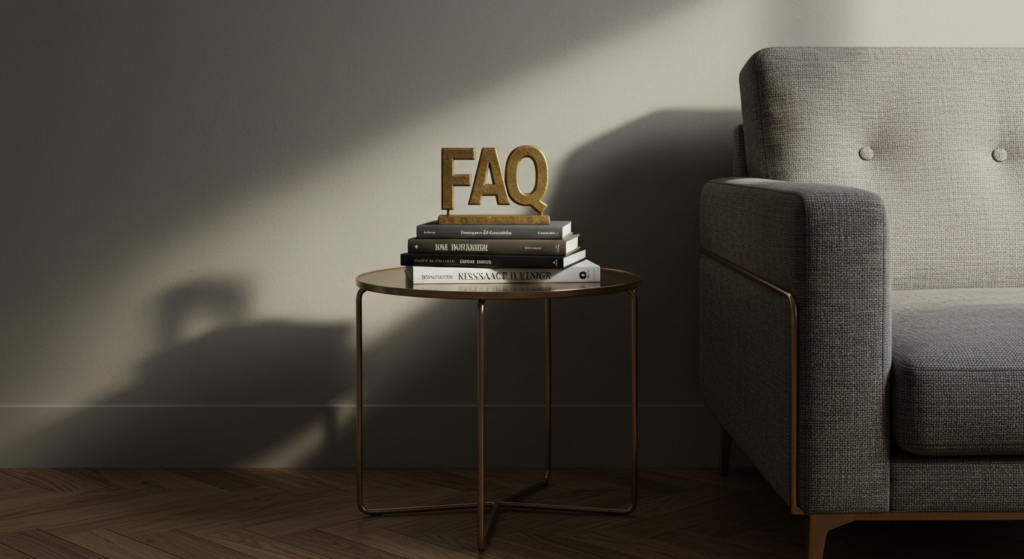
1. Can I mix more than two metal finishes in the same room?
Yes, but it’s best to do so with a plan. Stick to one main finish and use the others sparingly for accents. Balance them throughout the space so no single area feels overloaded.
2. What if my walls are bright or patterned?
Metallic accents can still work. Choose finishes that either match one color in your pattern or act as a neutral highlight. For bright walls, more subdued metals like brushed nickel or bronze can help ground the look.
3. Do I have to match metallic accents to my lighting fixtures?
No, but it helps if they share a similar style or shade. For instance, if your fixtures are brass, adding a nearby gold-framed mirror can make the whole area look unified. If you prefer a mix, aim for at least one element in the room that ties everything together.
4. How can I keep polished metals fingerprint-free?
Use a soft cloth regularly and wipe away any smudges as you see them. For items like doorknobs that get handled often, consider a brushed finish that hides fingerprints. Polished metals look amazing, but they do require frequent upkeep.
5. Is there an ideal number of metallic items per room?
There’s no strict rule. It depends on the room’s size, lighting, and color palette. Start with a few metallic pieces—like a table lamp, vase, or decorative tray—and see if you need more. The goal is to keep things balanced, not busy.
6. Are there any metals I should avoid in moist regions?
Uncoated iron can rust easily in damp places, so consider powder-coated or stainless steel if you live in a humid environment. For bathroom fixtures, many designers prefer brass, chrome, or brushed nickel because they resist corrosion better than some other metals.
7. Do all my door handles need to be the same finish as my furniture accents?
Not necessarily, but consistency in each area makes your design look polished. If your home has open-concept spaces, matching your door handles to the main metal accents can create a cohesive look.
8. Will metallic wallpaper overpower my furniture?
It depends on the pattern. Large or bold metallic designs can grab attention, so make sure your furniture complements rather than competes. In many cases, toned-down metals or smaller metallic motifs provide just enough shine without upstaging your furniture.
9. Can I use mixed metals in my kitchen if I already have stainless steel appliances?
Yes, but use other metals strategically. Maybe your cabinet handles are a different finish, like brushed brass, but your light fixtures have a hint of that same brass. Keep the theme going to tie it all together.
10. Are metallic floors a good idea?
Metallic floor tiles or coatings can look unique, but they tend to reflect a lot of light and might show scratches more easily. If you choose a metallic floor, pair it with simpler furniture and keep other metal elements subtle.
11. How can I test metallic accents without fully committing?
Try metallic accessories first—like tableware or small plant pots. If you enjoy the look, move on to bigger items like wall art or fixtures. This approach lowers the risk of regret and extra costs.
12. Does matte metal hide dirt better than polished metal?
Often, yes. Matte surfaces won’t show fingerprints or smudges as clearly. If your home sees a lot of daily use, matte or brushed finishes might save you from frequent polishing.
13. Can metallic paint replicate the same effect as actual metal?
Metallic paint can add shine, but it won’t offer the same texture or reflections as genuine metal. It’s a budget-friendly choice for smaller accents, like picture frames or vases. If you want depth and durability, real metal finishes usually work better.
14. Do metallic accents suit any interior design style?
Most styles can work with the right metal. Modern spaces lean toward chrome or nickel, while rustic rooms favor copper or bronze. Transitional or eclectic designs might mix several metals. The main goal is achieving harmony with your colors and furnishings.
That’s it—practical ways to integrate metallic glimmer into your home’s color scheme. Whether you pick gold, silver, copper, or a mix of metals, each accent can bring life to your space. When balanced well, these bright touches turn everyday rooms into polished retreats.

Neha Z. is not just any writer; she’s a storyteller who has graced the online world with her evocative prose for over half a decade. Venturing into the intricate nuances of women’s lives, she weaves stories that range from life’s highs and lows to the multifaceted essence of femininity. Each piece she pens radiates sincerity and artistry. As you delve into Neha’s musings, you’ll find reflections that echo your own journey and insights that inspire. Immerse yourself in her world, and let her stories touch your heart.
Reviewed By: Joanna Perez and Anna West
Edited By: Lenny Terra
Fact Checked By: Matthew Mansour
Photos Taken or Curated By: Matthew Mansour
